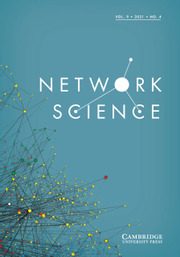Article contents
Comparing membership interest group networks across space and time, size, issue and industry*
Published online by Cambridge University Press: 12 February 2015
Abstract
We compare and contrast the network formation of interest groups across industry and issue area. We focus on membership interest groups, which by virtue of representing the interests of voluntary members face particular organizational and maintenance constraints. To reveal their cooperative behavior we build a network dataset based on cosigner status to United States Supreme Court amicus curiae briefs and analyze it with exponential random graph models and multidimensional scaling. Our methodological approach culminates in a clear and compact spatial representation of network similarities and differences. We find that while many of the same factors shape membership networks, religious, labor, and political organizations do not share the same structure as each other or as the business, civic and professional groups.
Keywords
Information
- Type
- Research Article
- Information
- Network Science , Volume 3 , Issue 1: Networks in Space and in Time: Methods and Applications , March 2015 , pp. 78 - 97
- Copyright
- Copyright © Cambridge University Press 2015
Footnotes
Authors are listed alphabetically. Earlier versions of this paper were presented at the 2013 ARS Conferene in Rome, Italy, and the 2012 Political Networks Conference in Boulder, Colorado. Further information on the original data and other papers on this project can be found at the project website: http://amicinetworks.com/.
References
- 15
- Cited by

